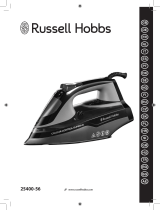
5
STEAM READY LIGHT
The steam ready light will ash while the iron is heating up. Wait until the steam ready light stops ashing
before trying to steam iron. Note that operating the steam trigger will have no eect until the steam ready
light stops ashing.
DRY IRONING
You can dry iron by just not pressing the steam button, but if you want to make sure you don’t press it
accidentally, then you should iron with an empty reservoir. You can do your dry ironing rst, then switch
o, ll the reservoir and do your steam ironing.
VERTICAL STEAMING
Remove wrinkles from hanging clothes, hanging curtains, and furnishing fabrics.
• Check that there’s adequate ventilation behind the fabric otherwise moisture may build up causing
mildew.
• Check that there’s nothing behind the fabric that may be damaged by the steam.
• Check that pockets, turn-ups, and cus are empty.
1. Set the temperature control to max.
2. Hold the iron close to (but not touching) the fabric.
We recommend using the steam button to produce steam for smaller areas, as it gives you better control.
AFTER USE
1. Put the iron on top of the base unit and turn the temperature control to •.
2. Set the on/o switch to O and unplug the base unit.
3. Empty the reservoir.
4. Let the iron cool down completely before cleaning it, moving it, or storing it away.
5. The steam pipe can be coiled together and placed into the hose clip.
6. Wrap the mains cable around the steam generator in an anti-clockwise direction then slot the plug
into the socket (Fig B).
CARE AND MAINTENANCE
1. Unplug the base unit, and let the appliance cool down fully.
2. Wipe outer surfaces with a damp cloth.
3. Remove spots from the soleplate with a little vinegar.
4. Take care not to scratch the soleplate.
ANTISCALE CARTRIDGE
To extend the life of the appliance and to avoid problems with lime scale, your steam generator is tted
with an anti-scale cartridge. The life of the anti-scale cartridge depends on the frequency of use and the
hardness of the water in your area. In a soft water area this should be about 100 uses. Do not put any
descaling products (including vinegar) into the reservoir. This can damage the appliance.
To replace the cartridge:
1. Switch o and unplug your steam generator
2. Allow your steam generator to cool down for at least 1 hour until the soleplate is cold.
3. Remove the reservoir from the front of the unit.
4. Pull the anti -scale cartridge vertically out of the reservoir. Note that the cartridge may contain water
when it is removed (Fig A).
5. Fit the new cartridge and push it down rmly into the water tank.
6. Rell and ret the reservoir.












